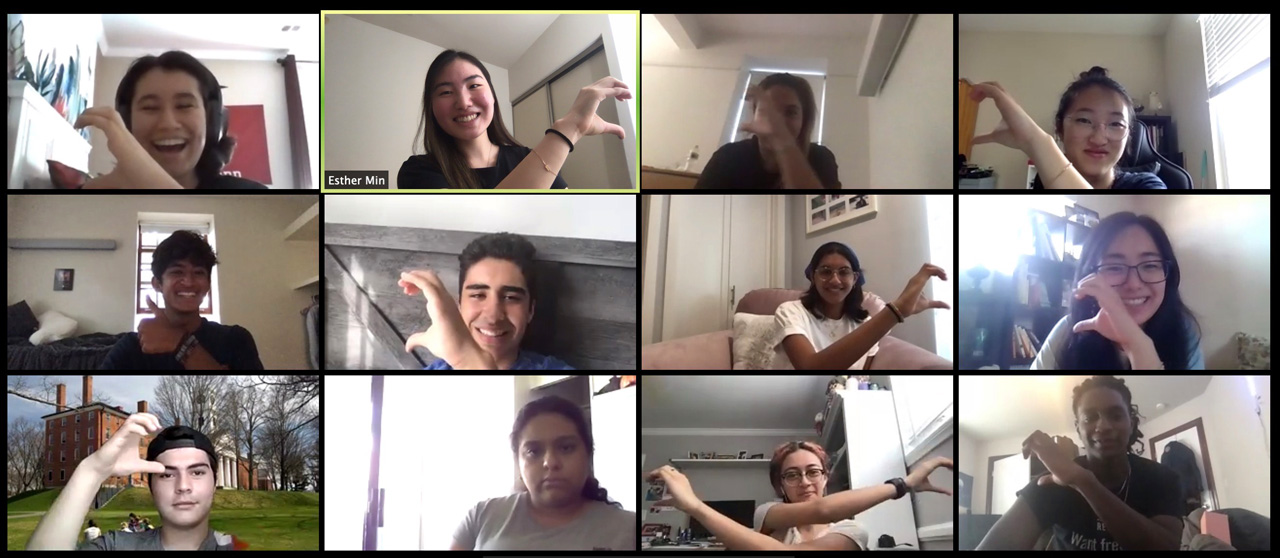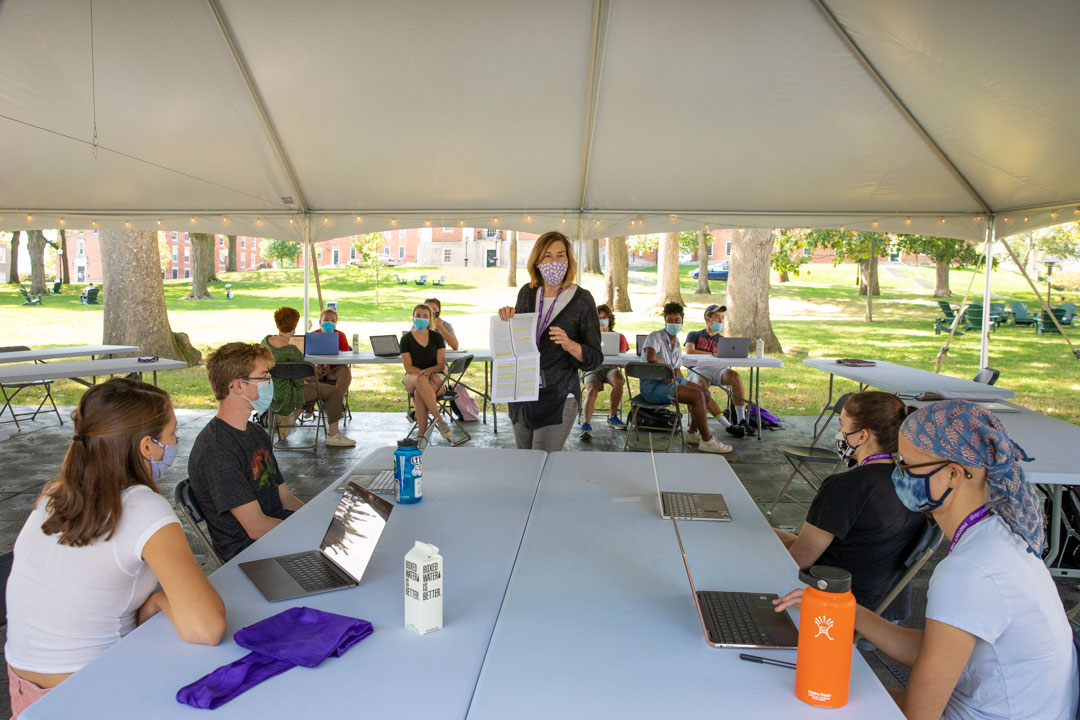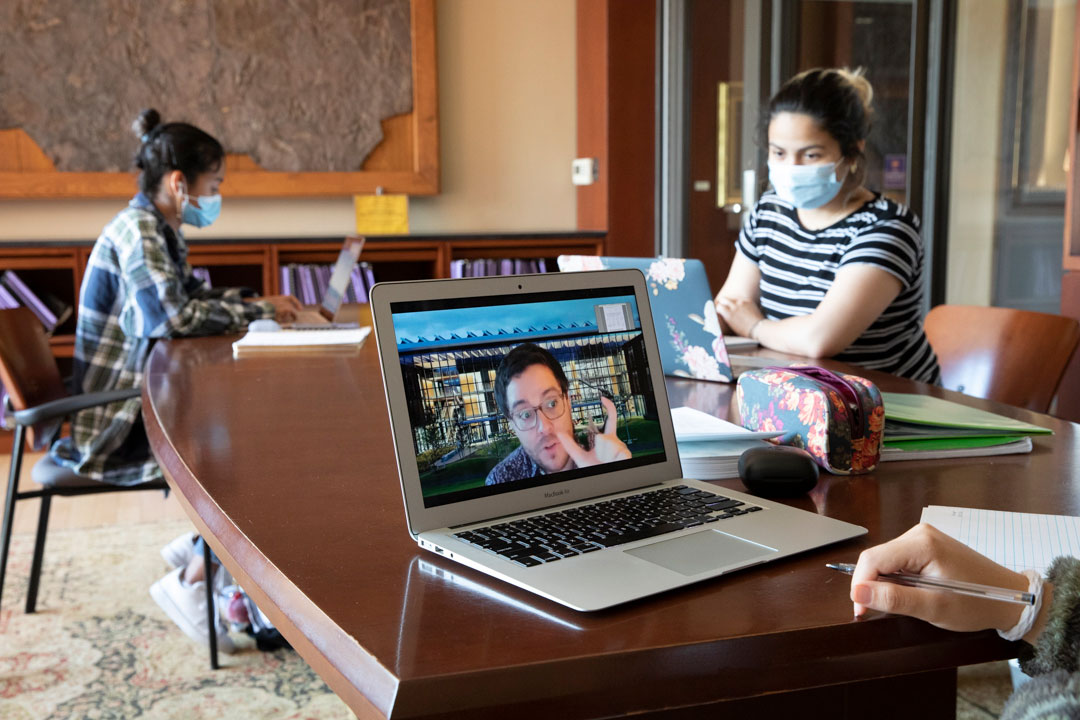
Orientation “squads” gathered virtually to begin getting to know each other.
There may not have been the usual boisterous student, faculty and staff welcoming crews. Or cars full of boxes and bags, or the requisite group picture of the class of 2024 packed onto Memorial Hill.
But there was nevertheless plenty of appropriately face-masked and physically distanced good cheer to go around when this year’s new students arrived at Amherst to start the 2020-21 academic year.
After taking a COVID-19 test as their first stop on campus and then, for some, spending time in quarantine before receiving clean bills of health, about 370 first-year and 10 transfer students settled into their homes at Amherst in August. Approximately 64 other first-years and transfers logged in from locations all over the world.
Because of COVID-19, the first-year class is smaller than it would be in a normal year, says Matthew McGann, dean of admission and financial aid.
But when the number of admitted first-years who deferred their admission until fall 2021 is added to those who enrolled this fall, 486 students accepted the College’s offer of admission—13 more than Amherst’s usual target of 473, says McGann. In addition, three transfer students deferred.
“Given these extraordinary times, we were flexible with students and families and let them make the enrollment decision that best fit their needs,” he says. “Having nearly 90 percent of these students choose to enroll this fall shows not only excitement for an Amherst education but also confidence in the investments Amherst has made to make this a successful year for a liberal arts education.”

Professor Nicola Courtright teaching a first-year seminar, "Encounters with Nature," in a tent on the main quad.
Cate Zolkos, dean of admission, says courage in the face of uncertainty and adversity is a major characteristic of this year’s batch of new students.
“They are also particularly kind, too,” she adds. “Their willingness to help peers, siblings, parents and grandparents, neighbors, other students in the community, people they’ll never meet, people across the state and beyond—the list goes on and on. It may be difficult to quantify, but it is so palpable. They are an incredibly caring group of individuals.”
What follows is some more information about these caring new students.
- They come to Amherst from 40 states; Washington, D.C.; Puerto Rico and 31 countries.
- 13% are non-American citizens.
- Many in this cohort have multiple and sometimes overlapping identities. Some include:
- Native American (1%)
- Asian American (21%)
- African American (15%)
- Native Hawaiian or Pacific Islander (1%)
- Latinx (17%)
- White (52%)
- Female (49%)
- Male (49%)
- Answering an optional gender identity question, seven students identify as nonbinary, and five as transgender.
- Nine Native American or Pacific Islander students join the student body. They are Chamorro, Chippewa, Hawaiian, Mono Lake Paiute, Northern Cheyenne, Potawatomi, and Pueblo and Samoan.
- 16% of the new students are first-generation college students.
- Of the 53% percent of students who graduated from public schools, 4% attended high school in rural areas.
- Fourteen are transfer students, seven of whom come to Amherst from community colleges across the country. One is a military veteran.
- The new students speak 44 different languages at home.
- They are French horn, saxophone, piano, violin, flute, cello, percussion, clarinet, trombone, bassoon and trumpet players.
- They are singers, composers, artists, actors and dancers.
- They are activists, athletes, humanitarians, museum curators, scientists and sociologists.
- They fight bullying and volunteer.
- They survive—and thrive—even in the most challenging of circumstances.
As in years past, a full academic profile of the incoming students will be available in a report that will be posted on the College’s website later in the fall.

Two students study in the Beneski Museum of Natural History while a third participates in an Organic Chemistry class via Zoom.